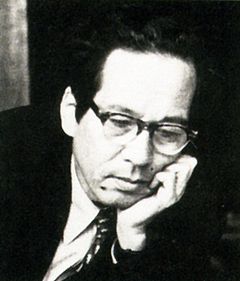- Nagai Tatsuo
-
Nagai Tatsuo 
Nagai TatsuoBorn 20 May 1904
Tokyo, JapanDied 12 October 1990 (aged 86)
Kamakura, Kanagawa, JapanOccupation Writer, poet, journalist Genres short stories, haiku
Influences- Kikuchi Kan, Kobayashi Hideo
In this Japanese name, the family name is "Nagai".Nagai Tatsuo (永井 龍男, 20 May 1904 – 12 October 1990) was a writer of short stories and haiku poetry active in the Shōwa period Japan, known for his portrayals of city life. Nagai was also known as a haiku poet under the pen-name of "Tomonkyo".
Contents
Early life
Nagai Tatsuo was born in Tokyo in impoverished circumstances. He was forced to quit school after graduation from elementary school due to his father's illness. However, he had already begun to exhibit signs of literary talent, and his first novel Kappan-ya no Hanashi ("Tale of a Printer's Shop") was published when he was 16. This novel won a prize in a competition and was highly praised by the well-known author and editor, Kikuchi Kan.
Literary career
Due to this encouragement, he devoted his energies to writing, publishing Kuroi Gohan ("Black Rice") in Bungeishunjū, a monthly literary journal founded by Kikuchi Kan. In 1924, together with the literary critic Kobayashi Hideo, he later launched his own monthly literary magazine called Yamamayu.
In 1927, while continuing to write, Nagai was hired as an editor for Bungeishunjū. During this time, he helped to lay the foundations for the Akutagawa and Naoki Prizes, created in 1935, and later became a member of the screening committee.
In 1942, he traveled to Manchukuo to establish a branch office of the Bungeishunjū, returning to Tokyo in 1944 to assume the post of executive director to the magazine.
However, due to his wartime activity as a correspondent, Nagai was purged from public service by the American occupation authorities after World War II. He then decided to concentrate on writing short stories as a profession. Asagiri (Morning Mist, 1947) was well-received by critics. He wrote a number of short novels, among them, Mikan,("Orange"), Ikko ("One"), and Aki ("Autumn"), which were collected in 1965 into an anthology titled Ikko sono ta ("One and Others"), which was awarded the Noma Prize and the Japan Art Academy Prize for that year.
Nagai became a member of the Japan Art Academy in 1968, and was awarded the Order of Culture by the Japanese government in 1981.
Nagai lived in Kamakura, Kanagawa Prefecture from 1934 until his death in 1990 at the age of 86. Nagai served as the first director of the Kamakura Bungakukan (Kamakura Museum of Literature) from 1985 to 1990. His grave is at the temple of Saikai-ji in Mita, Tokyo.
See also
- Japanese literature
- List of Japanese authors
External links
References
- Washburn Dennis. Studies in Modern Japanese Literature: Essays and Translations in Honor of Edwin McClellan. The Journal of Asian Studies, Vol. 58, No. 1 (Feb., 1999), pp. 217–220
Categories:- 1904 births
- 1990 deaths
- Writers from Tokyo
- Japanese writers
- Japanese short story writers
- Japanese poets
Wikimedia Foundation. 2010.
